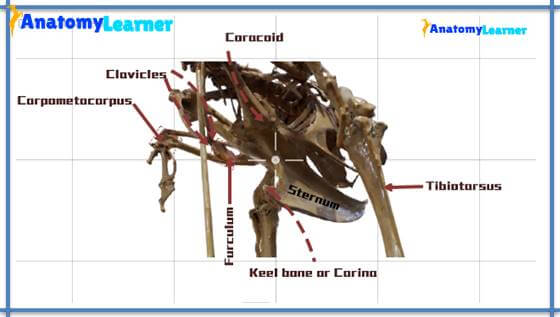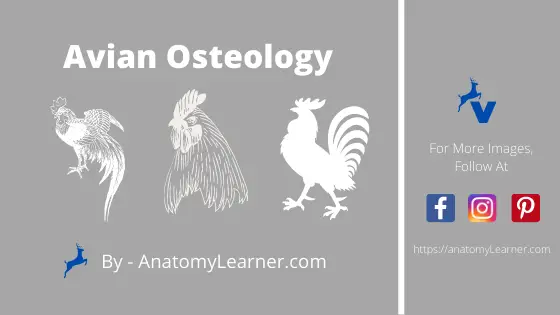Do you want to learn about avian osteology?
Thanks for choosing anatomylearn to learn bird skeletal anatomy. In this article I will discuss on avian osteology. There are 9+ amazing facts that you should know about bird skeleton.
Here, I am going to focus on bird bone identification. If possible I will try to cover scapula bone of bird details.
After reading this article you will able to understand the difference of bird bone vs mammals bones. You will get avian osteology pdf at the end of this article.
Want to learn bird skeletal anatomy?
Okay, let’s find the 9+ amazing facts about bird osteology.
Avian osteology
I would like to provide some amazing facts about avian osteology that you should know.
#1. Most of avian skeleton exhibits lightness and strength
#2. Fusion of bone occurred in cranium and pelvic bones. These provide more strength and rigidity to avian bone.
#3. Fusion with deletion of bone occurred to a great extent in wing and pelvic limb bone
#4. There are extensive air sac systems into many bones. These air sacs provide lightness to bone.
#5. There are four to six thoracic vertebrae in bird skeleton. Two or more thoracic vertebrae fused to form a single bone. This bone is known as notarium or os dorsale.
#6. Lumbar and sacral vertebrae fused to form single bone. The name of this bone is synsacrum.
#7. Last 4 to 8 caudal vertebrae fused to form unique structure pygostyle.
#8. Preen gland founds at the tip of pygostyle
#9. The vertebral ribs possess a caudal extension called uncinate process. This overlap to succeeding ribs of bird.
#10. Two slender rod like clavicles fused to form furculum
Now you will learn these amazing facts of bird skeleton in details.

Bird bone identification
I will try to identify the following osteological features from bird skeleton.
From axial skeleton –
- #1. Skull – including hyoid bone
- #2. Vertebrae column
- #3. Notarium
- #4. Synsacrum
- #5. Pygostyle
- #6. Ribs of aves
- #7. Uncinate process
- #8. Sternum

From appendicular skeleton of bird –
- #1. Limb bones
- #2. Pectoral and pelvic girdle
- #3. Coracoid bone
- #4. Clavicle
- #5. Furculum
- #6. Scapula
- #7. Humerus
- #8. Radius
- #9. Carpometacarpus and phalanges
- #10. Ilium, ischium and pubis
- #11. Femur (thigh bone)
- #12. Tibiotarsal 9largest bone of leg)
- #13. Tarsometatarsus and phalanges
I think you have completed half of avian osteology. Try to know more of bird skeleton anatomy.
Bird skeleton anatomy (avian osteology)
I am going to start with avian vertebral column. Please find bird skull anatomy at avian anatomy section.
Vertebral formula of avian species – C14 T7 L+S 14 Co 4-9
Want to memorize vertebral column?
You should always figure out these following points about vertebral column –
#1. Series of vertebrae articulate together
#2. Form long column of axial skeleton in the body
I am not interest to provide a long description of each bone from avian osteology. You may find description at veterinary anatomy.
I would like to provide the exception of each bone from bird skeleton.
Want to know atlas of bird?
Atlas – is small ring like bone
Cranial surface is deeply concave for articulation of single occipital condyle
Caudal surface has three articular facets. These contacts with axis of bird
Other vertebrae are heterocoelous. They have saddle shaped articular surface.

Exception of vertebrae of avian osteology
Vertebrae are divided into –
#1. Cervical vertebrae
#2. Thoracic vertebrae
#3. Lumbar and sacral vertebrae
#4. Caudal vertebrae
There are large numbers of vertebrae of avian skeleton. They often show fusion in thoracic region. They always show fusion in sacral and caudal region.
Features of cervical vertebrae are –
#1. Connect with atlas cranially
#2. Proceeding caudally to first thoracic vertebrae with sternal rib
#3. Last two cervical vertebrae possess vertebral segment of rib
Want to know the exception of thoracic vertebrae?
They are mainly four to six in number
They possess both vertebral and sternal part of rib
Articulate with sterocostal processes of sternum
Two or more thoracic vertebrae fuse to form single bone notarium. Another name of this bone is os dorsale. But notarium is absent in duck and geese.
Lumbar and sacral vertebral fuse to form single bone called synsacrum. This synsacrum often fused laterally with ilia bone.
Caudal vertebrae from avian osteology
You will also found some exception in caudal vertebrae of bird skeleton.
They locates caudal to synsacrum bone
Possess 4 – 9 vertebrae. It’s may very within species.
Fusion of last four to eight embryonic caudal vertebrae forms a unique structure. The name of this unique structure is pygostyle.
Pygostyle have major role in flight.
At the tip of pygostyle you will find preen gland. Paygostyle partitions this preen gland. Preen gland is absent in parrot and pigeon.
Preen gland is very important for water bird. They help in waterproofing the feathers.

Exception of ribs and sternum from avian osteology
There are seven pairs of ribs in avian species. Each rib consists of two segments like –
#1. Dorsal segment know as vertebral rib
#2. Ventral segment known as sternal rib
Dorsal ribs possess two articulations with the corresponding vertebrae
First two of seven pairs of ribs lack ventral segment. They have no articulation with sternum.
Other ribs – called sternal ribs. They articulate dorsally with vertebral rib and ventrally with sternocostal process of sternum.
You will find uncinate process in vertebral ribs. They are the caudal extension of vertebral ribs. Uncinate processes overlap the succeeding ribs. It provides rigidity to thoracic cage of bird skeleton.
Uncinate process is absent in first and last ribs.
Would you like to know sternum of bird?
Sternum is extensive bone in bird. It possesses a large ventrally directed keel bone. Another name of keel bone is carina.
Carina serves as bony surface for origin of major flight muscles in bird.
Caudal to sternum you will find a large opening. Bird sternum is four notched and they have –
#1. Caudolateral processes
#2. Lateral metasternal processes
Cranial most point of sternal keel known as cranial apex.
Know more about sternum in general at here.
Scapula bone of bird
Do you know about bones of pectoral girdle?
The bones of pectoral girdle are –
#1. Fused clavicles (furcula)
#2. Coracoid
#3. Scapula
The important features of coracoid bone of avian osteology are –
#1. Most robust bone
#2. Directed ventrally and caudally
#3. Articulates with sternum at coraoidal sulcus
# 4. Hollow and contain air saces
Osteological features of clavicles of bird skeleton –
#1. Slender rod like structure
#2. Fused to form flatten plate vebtrally. The name of this flatten plate is furculum.
#3. Connected to apex of sternum by hypocledial ligament
Important osteological features of scapula bone of bird –
It is long, flat and directed caudally
#2. Parallel to vertebral column
#3. Thicker at proximal end and near acromion process
You may learn scapula of mammals in details at here.
Wing bone from avian osteology
Hope you know the wing bones of bird. I would like to provide a little information about these bones. Start with humerus of bird –
Humerus is the largest wing bone of bird
Articulates proximally with pectoral girdle at glenoid fossa
Presence of pneumatic foramen at its proximal end
Articulates with radius ulna by two condyle distally
Most important features of radius ulna of bird are –
#1. Ulna bone larger than radius
#2. Both bone equal in length
#3. Proximal end of radius articulates with smaller of humeral condyle
#4. Distal extremity of radius have small facet for articulation of ulna. It also articulates with carpometacarpal bones
Osteological features of carpometacarpal bones of bird skeleton –
#1. Represent three fused elements – metacarpal II, II and IV.
#2. Metacarpal II is small projection on radial side
#3. Metacarpal III and IV are long element. They fused at their distal extremities.
#4. Digit III is largest and contains two phalanges
#5. Digit II and IV contain one phalange

Bones of pelvic girdle
There are three fused bone – ilium, ischium and pubis. Ilium also fused with synsacrum. Ilium and ischium formed ilioischiatic foramen. The pubis is long and thin. It directed caudally and fused cranially with ischia.
Acetabulum of bird skeleton
It lies between ilium and ischium. It accommodates head of femur.
Tibiotarsus of bird
It is the largest of leg bones
It has condyle for articulation with femur. There is a large cnemial crest at tibiotarsus. Extensor muscle of leg origins from cnemial crest.
Presence of nutrient foramen at the caudal shaft of tibiotarsus
Have ridge for attachment of fibula at lateral part of upper shaft
Distal extremity presents prominent condyle. It articulates with tarsometarsus.
Tarsometatarsus of bird skeleton
The important osteological features of tarsometatarsus of bird skeleton are –
#1. Presence of internal and external condyle proximally
#2. Articulates with tibiotarsus with these condyles
#3. Have series of calcaneal ridge at planter
#4. Have three large trochlea at distal end
#5. Have three digit II, III and IV
#6. Digit II has three phalanges
#7. Digit III has four phalanges
#8. Digit IV has five phalanges
Conclusion
Hope you got a better idea about avian osteology. Please watch the video carefully to learn bird skeleton anatomy.
You may practice again and perform bird bone identification. Please let me inform if you need avian osteology pdf.
Do you think this article was valuable for you to know bird skeleton anatomy? I would like to request you to share this article with your friends who are interest to learn bird bone identification.
I used to publish article like scapula bone of bird in a regular basis. Do you want to know more about bird skull anatomy? You may follow this blog to learn bird skull id. For quick update about the articles please follow anatomylearner at social media.
Could you please make difference of bird bones vs mammals bones?
Do you think this information is enough about avian osteology? If you have any suggestion about bird skeleton then I would like to request you to inform me at comment box. Do you found any mistake at bird bone diagram? Please let me inform through direct message. I will happy and always appreciate your suggestion for this avian skeleton article.

